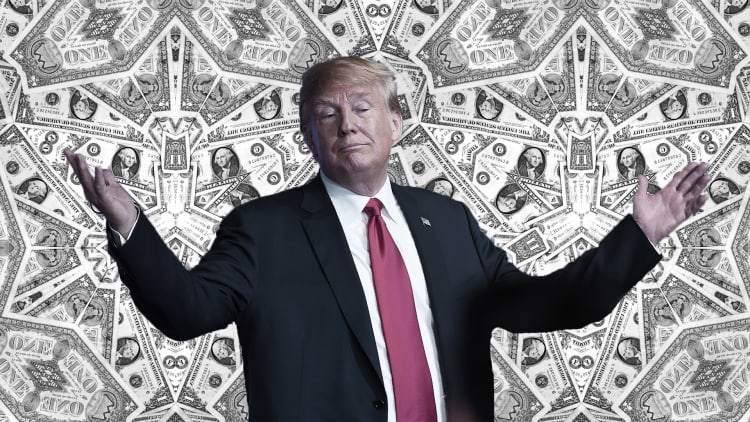Trump then vs. now
| Click to edit | Pre-election (10/16) | Through 9/18 | Change |
|---|---|---|---|
| Employment | |||
| Nonfarm employees (millions) | 145.1 | 149.5 | 4.4 |
| Unemployment rate | 4.90% | 3.70% | (1.2) pp |
| Labor participation rate | 62.80% | 62.70% | (0.1) pp |
| Avg hourly earnings | $25.88 | $27.24 | 5% |
| Surveys | |||
| Consumer confidence | 101 | 138 | 37 |
| NFIB Small Biz Optimism | 95 | 108 | 13 |
| ISM manufacturing | 52 | 60 | 8 |
| Government | |||
| Corp tax rate | 35% | 21% | (14) pp |
| Budget deficit (% of GDP) | 2.90% | 3.8% | 0.7 pp |
| Federal debt ($ trillion) | $19.80 | $21.5) | 9% |
| Assets held by the Fed ($ trillion) | $4.52 | $4.22 | -6% |
| Markets | |||
| S&P 500 | 2,126 | 2,810 | 32% |
| S&P EPS | $117 | $140 | 20% |
| S&P 500 fwd P/E | 17X | 16.3X | (0.7X) |
| Nasdaq 100 | 4,861 | 7,178 | 48% |
| Rates | |||
| Fed funds rate | 0.30% | 2.20% | 187 bp |
| 10-year Treasury yield | 1.80% | 3.10% | 121 bp |
Source: Source: FactSet, Haver Analytics, and Goldman Sachs Global Investment Research
Since Donald Trump won the presidency, he has presided over one of the most tumultuous political times in recent memory as well as the best economy the country has seen since well before the financial crisis. Consumer and small business confidence is up — but so are both the national debt and budget deficit.
The chart above, using mostly data compiled by Goldman Sachs, quantifies just how much things changed from the days just before the election in November 2016 through September 2018.
Of course, the stock market has weakened in October, which has been its historically most volatile month. The chart doesn't include GDP, which has averaged 2.72 percent since Trump took over, compared with the 1.6 percent gain in 2016.
But the numbers provide a solid overview of how conditions have evolved during the 45th president's time in office.
— Graphic by CNBC's John Schoen.
Watch: Where Trump gets credit on the economy, and what could go wrong

—Correction: An earlier version misstated the deficit-to-GDP ratio.


